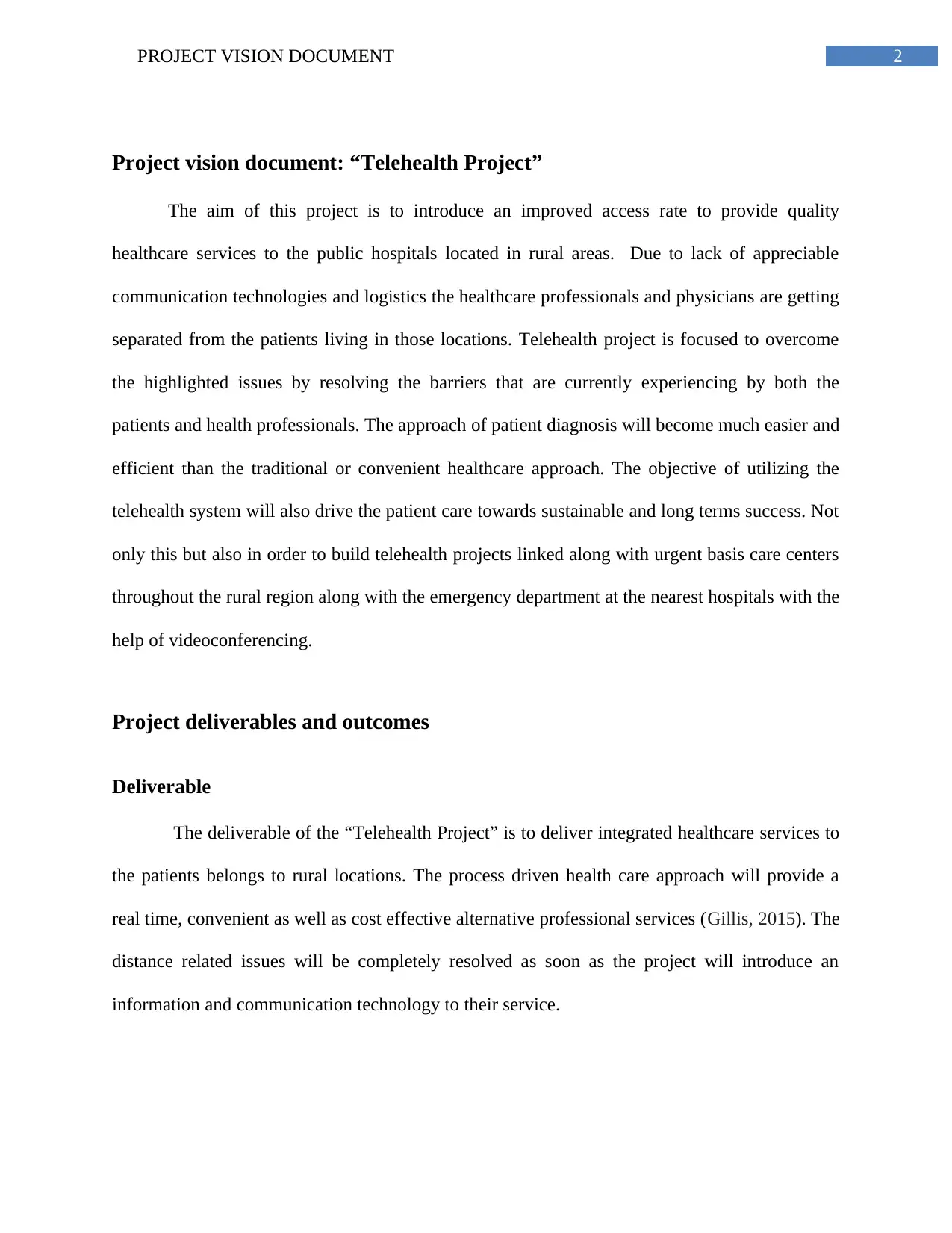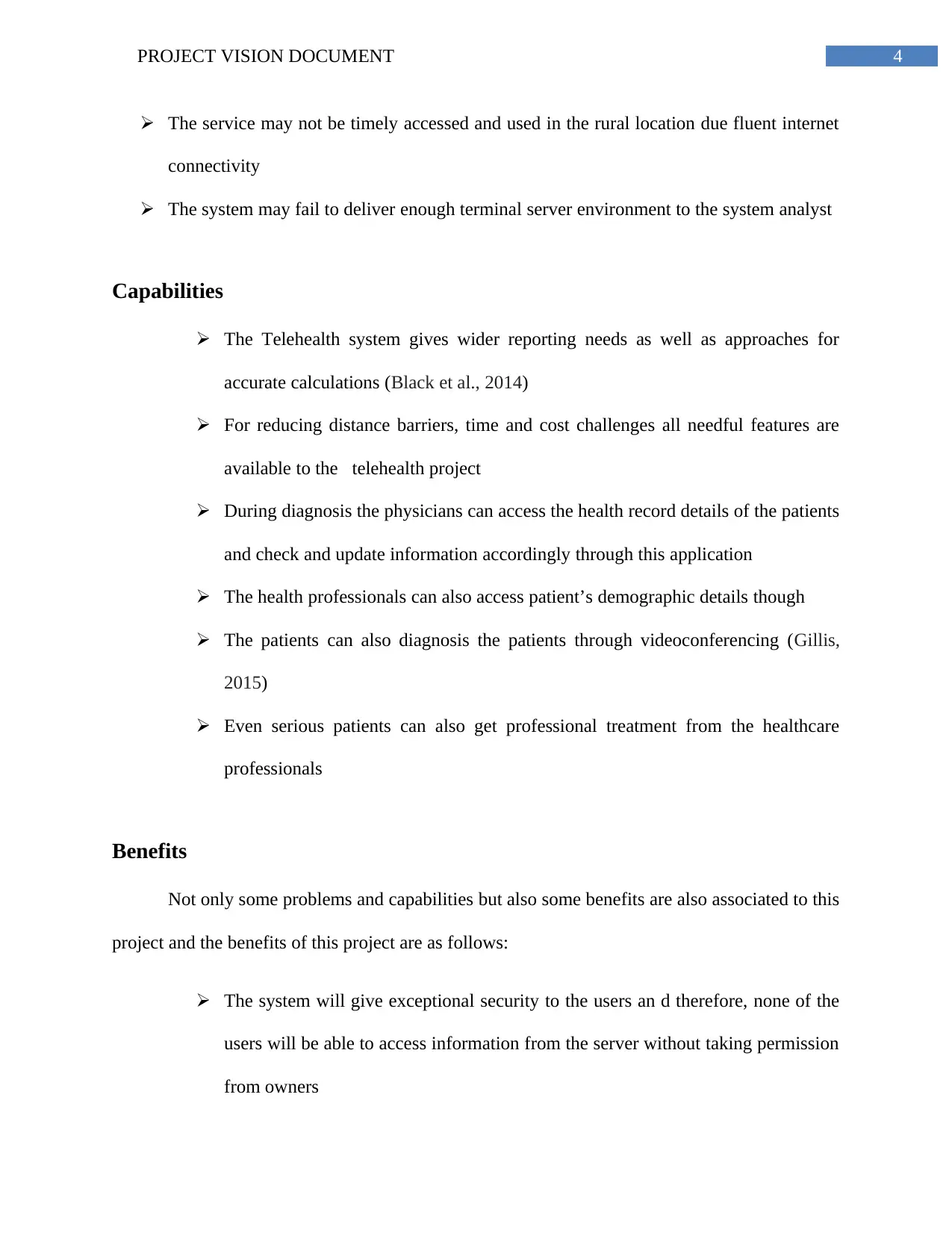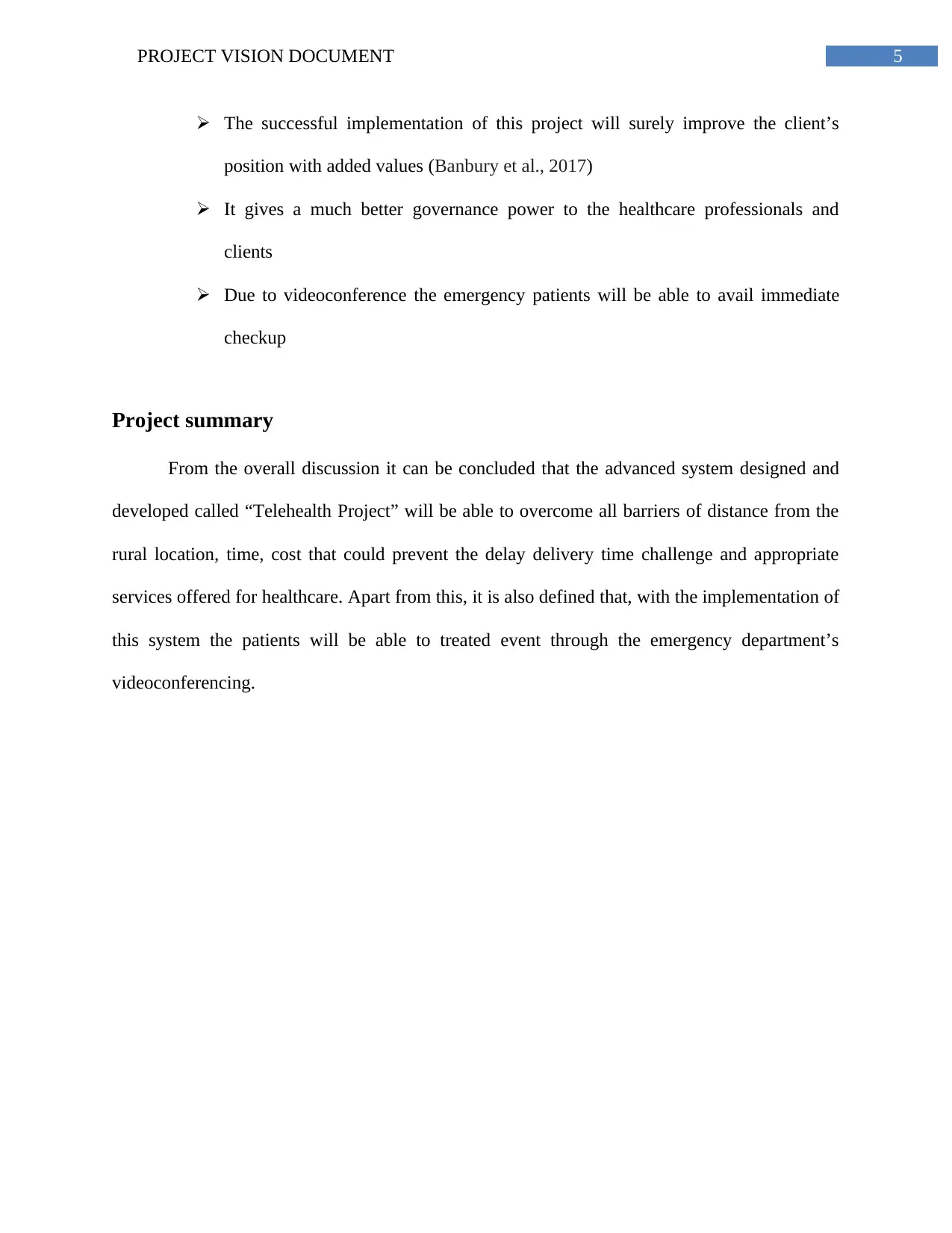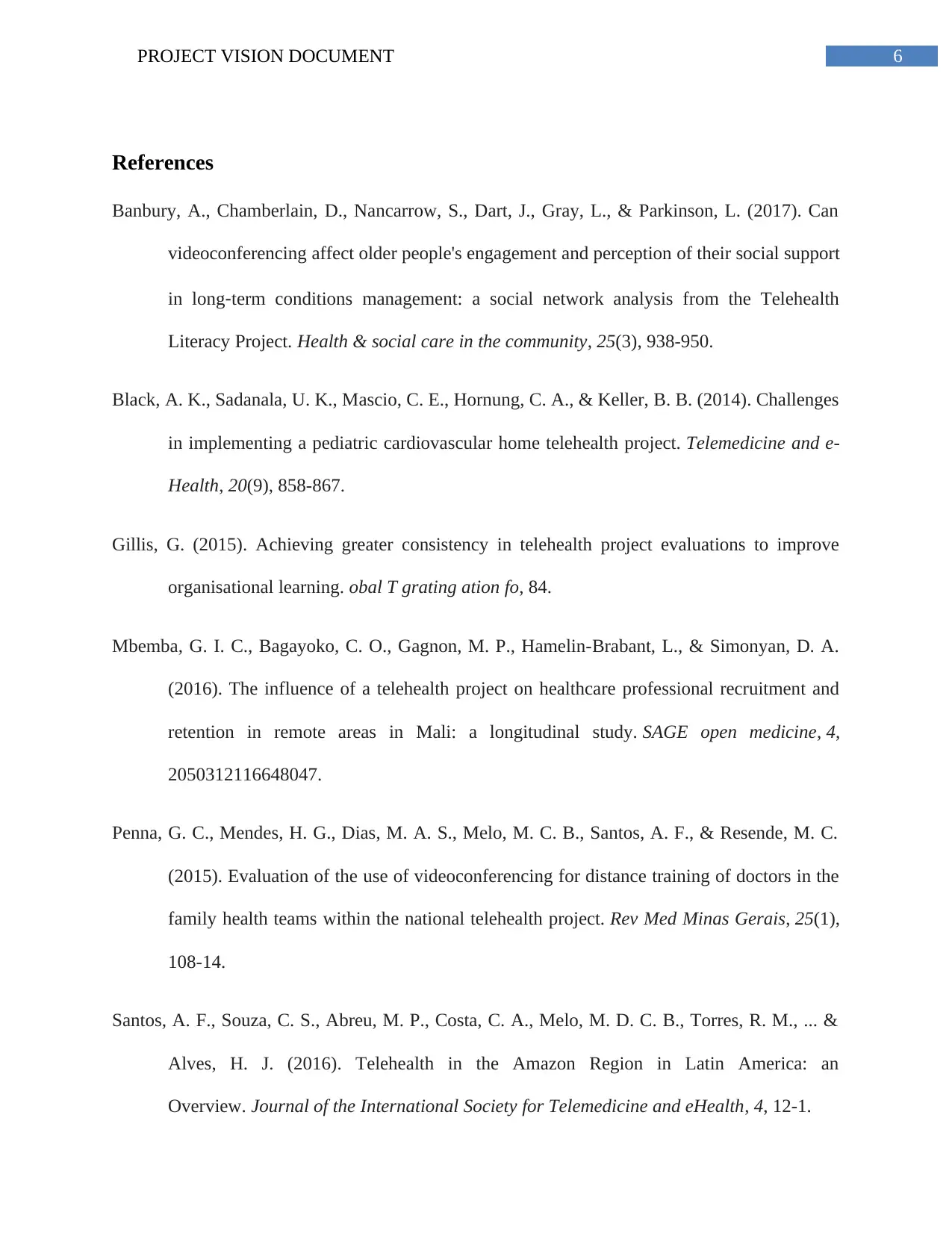Telehealth Project Vision Document: Rural Healthcare Improvement
VerifiedAdded on 2021/12/27
|6
|1204
|24
Project
AI Summary
This project vision document outlines a Telehealth Project aimed at enhancing healthcare access in rural areas by overcoming communication and logistical barriers. The project focuses on improving patient diagnosis efficiency and providing sustainable patient care through integrated healthcare services, including videoconferencing for emergency care. The document details project deliverables, such as real-time and cost-effective healthcare solutions, and outcomes like overcoming distance-related issues. It also identifies challenges like cost and technological limitations, while highlighting capabilities such as improved reporting and patient data access for healthcare professionals. The benefits include enhanced security and improved client positions, alongside the project's potential to offer immediate care via videoconferencing for emergency cases. Overall, the Telehealth Project is designed to address distance, time, and cost barriers, ensuring timely and appropriate healthcare services, including emergency department consultations.

Running head: PROJECT VISION DOCUMENT
Project vision document: “Telehealth Project”
Name of the student:
Name of the university:
Project vision document: “Telehealth Project”
Name of the student:
Name of the university:
Paraphrase This Document
Need a fresh take? Get an instant paraphrase of this document with our AI Paraphraser

2PROJECT VISION DOCUMENT
Project vision document: “Telehealth Project”
The aim of this project is to introduce an improved access rate to provide quality
healthcare services to the public hospitals located in rural areas. Due to lack of appreciable
communication technologies and logistics the healthcare professionals and physicians are getting
separated from the patients living in those locations. Telehealth project is focused to overcome
the highlighted issues by resolving the barriers that are currently experiencing by both the
patients and health professionals. The approach of patient diagnosis will become much easier and
efficient than the traditional or convenient healthcare approach. The objective of utilizing the
telehealth system will also drive the patient care towards sustainable and long terms success. Not
only this but also in order to build telehealth projects linked along with urgent basis care centers
throughout the rural region along with the emergency department at the nearest hospitals with the
help of videoconferencing.
Project deliverables and outcomes
Deliverable
The deliverable of the “Telehealth Project” is to deliver integrated healthcare services to
the patients belongs to rural locations. The process driven health care approach will provide a
real time, convenient as well as cost effective alternative professional services (Gillis, 2015). The
distance related issues will be completely resolved as soon as the project will introduce an
information and communication technology to their service.
Project vision document: “Telehealth Project”
The aim of this project is to introduce an improved access rate to provide quality
healthcare services to the public hospitals located in rural areas. Due to lack of appreciable
communication technologies and logistics the healthcare professionals and physicians are getting
separated from the patients living in those locations. Telehealth project is focused to overcome
the highlighted issues by resolving the barriers that are currently experiencing by both the
patients and health professionals. The approach of patient diagnosis will become much easier and
efficient than the traditional or convenient healthcare approach. The objective of utilizing the
telehealth system will also drive the patient care towards sustainable and long terms success. Not
only this but also in order to build telehealth projects linked along with urgent basis care centers
throughout the rural region along with the emergency department at the nearest hospitals with the
help of videoconferencing.
Project deliverables and outcomes
Deliverable
The deliverable of the “Telehealth Project” is to deliver integrated healthcare services to
the patients belongs to rural locations. The process driven health care approach will provide a
real time, convenient as well as cost effective alternative professional services (Gillis, 2015). The
distance related issues will be completely resolved as soon as the project will introduce an
information and communication technology to their service.

3PROJECT VISION DOCUMENT
Outcome
As per the implemented integrated patient care system some of the highlighted issues
will be resolved and some of them will be minimized (Santos et al., 2016). It is expected that, the
currently experienced issues by the consumer and physicians in terms of time, cost, distance that
may prevent the delivery time, education support and healthcare services will overcome with the
implementation of this telehealth system. This alternative system can control the patient’s health
by retrieving the data stored in the data centre. Apart from this, the problems, benefits and
capabilities of the Telehealth project are also demonstrated in this project vision document.
Problems
For the Telehealth project one problem which has been highlighted is cost. Due to
needful economical and commercial support some regulation or license are restricted
(Mbemba et al., 2016). As a result the multistate system will fail to deliver all multistate
healthcare prcatices
As the system is completely based on information and communication technology
therefore, some of the applications of telemedicine are not working accurately in the rural
locations
Telemedicine of telehealth is all about technology based service to resolve the distance
issue but multiple number of technology implementation will create high level data flow
challenge (Penna et al., 2015).
Apart from this, some of the telehealth applications are showing great progress rate but
the areas that lack large study or other than that needs further synthesis is facing serious
problems.
Outcome
As per the implemented integrated patient care system some of the highlighted issues
will be resolved and some of them will be minimized (Santos et al., 2016). It is expected that, the
currently experienced issues by the consumer and physicians in terms of time, cost, distance that
may prevent the delivery time, education support and healthcare services will overcome with the
implementation of this telehealth system. This alternative system can control the patient’s health
by retrieving the data stored in the data centre. Apart from this, the problems, benefits and
capabilities of the Telehealth project are also demonstrated in this project vision document.
Problems
For the Telehealth project one problem which has been highlighted is cost. Due to
needful economical and commercial support some regulation or license are restricted
(Mbemba et al., 2016). As a result the multistate system will fail to deliver all multistate
healthcare prcatices
As the system is completely based on information and communication technology
therefore, some of the applications of telemedicine are not working accurately in the rural
locations
Telemedicine of telehealth is all about technology based service to resolve the distance
issue but multiple number of technology implementation will create high level data flow
challenge (Penna et al., 2015).
Apart from this, some of the telehealth applications are showing great progress rate but
the areas that lack large study or other than that needs further synthesis is facing serious
problems.
⊘ This is a preview!⊘
Do you want full access?
Subscribe today to unlock all pages.

Trusted by 1+ million students worldwide

4PROJECT VISION DOCUMENT
The service may not be timely accessed and used in the rural location due fluent internet
connectivity
The system may fail to deliver enough terminal server environment to the system analyst
Capabilities
The Telehealth system gives wider reporting needs as well as approaches for
accurate calculations (Black et al., 2014)
For reducing distance barriers, time and cost challenges all needful features are
available to the telehealth project
During diagnosis the physicians can access the health record details of the patients
and check and update information accordingly through this application
The health professionals can also access patient’s demographic details though
The patients can also diagnosis the patients through videoconferencing (Gillis,
2015)
Even serious patients can also get professional treatment from the healthcare
professionals
Benefits
Not only some problems and capabilities but also some benefits are also associated to this
project and the benefits of this project are as follows:
The system will give exceptional security to the users an d therefore, none of the
users will be able to access information from the server without taking permission
from owners
The service may not be timely accessed and used in the rural location due fluent internet
connectivity
The system may fail to deliver enough terminal server environment to the system analyst
Capabilities
The Telehealth system gives wider reporting needs as well as approaches for
accurate calculations (Black et al., 2014)
For reducing distance barriers, time and cost challenges all needful features are
available to the telehealth project
During diagnosis the physicians can access the health record details of the patients
and check and update information accordingly through this application
The health professionals can also access patient’s demographic details though
The patients can also diagnosis the patients through videoconferencing (Gillis,
2015)
Even serious patients can also get professional treatment from the healthcare
professionals
Benefits
Not only some problems and capabilities but also some benefits are also associated to this
project and the benefits of this project are as follows:
The system will give exceptional security to the users an d therefore, none of the
users will be able to access information from the server without taking permission
from owners
Paraphrase This Document
Need a fresh take? Get an instant paraphrase of this document with our AI Paraphraser

5PROJECT VISION DOCUMENT
The successful implementation of this project will surely improve the client’s
position with added values (Banbury et al., 2017)
It gives a much better governance power to the healthcare professionals and
clients
Due to videoconference the emergency patients will be able to avail immediate
checkup
Project summary
From the overall discussion it can be concluded that the advanced system designed and
developed called “Telehealth Project” will be able to overcome all barriers of distance from the
rural location, time, cost that could prevent the delay delivery time challenge and appropriate
services offered for healthcare. Apart from this, it is also defined that, with the implementation of
this system the patients will be able to treated event through the emergency department’s
videoconferencing.
The successful implementation of this project will surely improve the client’s
position with added values (Banbury et al., 2017)
It gives a much better governance power to the healthcare professionals and
clients
Due to videoconference the emergency patients will be able to avail immediate
checkup
Project summary
From the overall discussion it can be concluded that the advanced system designed and
developed called “Telehealth Project” will be able to overcome all barriers of distance from the
rural location, time, cost that could prevent the delay delivery time challenge and appropriate
services offered for healthcare. Apart from this, it is also defined that, with the implementation of
this system the patients will be able to treated event through the emergency department’s
videoconferencing.

6PROJECT VISION DOCUMENT
References
Banbury, A., Chamberlain, D., Nancarrow, S., Dart, J., Gray, L., & Parkinson, L. (2017). Can
videoconferencing affect older people's engagement and perception of their social support
in long‐term conditions management: a social network analysis from the Telehealth
Literacy Project. Health & social care in the community, 25(3), 938-950.
Black, A. K., Sadanala, U. K., Mascio, C. E., Hornung, C. A., & Keller, B. B. (2014). Challenges
in implementing a pediatric cardiovascular home telehealth project. Telemedicine and e-
Health, 20(9), 858-867.
Gillis, G. (2015). Achieving greater consistency in telehealth project evaluations to improve
organisational learning. obal T grating ation fo, 84.
Mbemba, G. I. C., Bagayoko, C. O., Gagnon, M. P., Hamelin-Brabant, L., & Simonyan, D. A.
(2016). The influence of a telehealth project on healthcare professional recruitment and
retention in remote areas in Mali: a longitudinal study. SAGE open medicine, 4,
2050312116648047.
Penna, G. C., Mendes, H. G., Dias, M. A. S., Melo, M. C. B., Santos, A. F., & Resende, M. C.
(2015). Evaluation of the use of videoconferencing for distance training of doctors in the
family health teams within the national telehealth project. Rev Med Minas Gerais, 25(1),
108-14.
Santos, A. F., Souza, C. S., Abreu, M. P., Costa, C. A., Melo, M. D. C. B., Torres, R. M., ... &
Alves, H. J. (2016). Telehealth in the Amazon Region in Latin America: an
Overview. Journal of the International Society for Telemedicine and eHealth, 4, 12-1.
References
Banbury, A., Chamberlain, D., Nancarrow, S., Dart, J., Gray, L., & Parkinson, L. (2017). Can
videoconferencing affect older people's engagement and perception of their social support
in long‐term conditions management: a social network analysis from the Telehealth
Literacy Project. Health & social care in the community, 25(3), 938-950.
Black, A. K., Sadanala, U. K., Mascio, C. E., Hornung, C. A., & Keller, B. B. (2014). Challenges
in implementing a pediatric cardiovascular home telehealth project. Telemedicine and e-
Health, 20(9), 858-867.
Gillis, G. (2015). Achieving greater consistency in telehealth project evaluations to improve
organisational learning. obal T grating ation fo, 84.
Mbemba, G. I. C., Bagayoko, C. O., Gagnon, M. P., Hamelin-Brabant, L., & Simonyan, D. A.
(2016). The influence of a telehealth project on healthcare professional recruitment and
retention in remote areas in Mali: a longitudinal study. SAGE open medicine, 4,
2050312116648047.
Penna, G. C., Mendes, H. G., Dias, M. A. S., Melo, M. C. B., Santos, A. F., & Resende, M. C.
(2015). Evaluation of the use of videoconferencing for distance training of doctors in the
family health teams within the national telehealth project. Rev Med Minas Gerais, 25(1),
108-14.
Santos, A. F., Souza, C. S., Abreu, M. P., Costa, C. A., Melo, M. D. C. B., Torres, R. M., ... &
Alves, H. J. (2016). Telehealth in the Amazon Region in Latin America: an
Overview. Journal of the International Society for Telemedicine and eHealth, 4, 12-1.
⊘ This is a preview!⊘
Do you want full access?
Subscribe today to unlock all pages.

Trusted by 1+ million students worldwide
1 out of 6
Related Documents
Your All-in-One AI-Powered Toolkit for Academic Success.
+13062052269
info@desklib.com
Available 24*7 on WhatsApp / Email
![[object Object]](/_next/static/media/star-bottom.7253800d.svg)
Unlock your academic potential
Copyright © 2020–2025 A2Z Services. All Rights Reserved. Developed and managed by ZUCOL.




